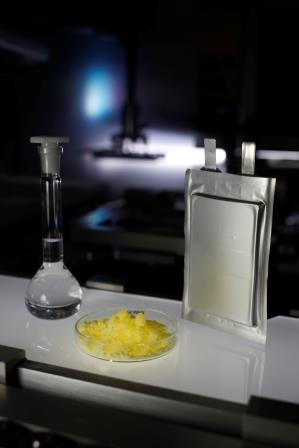Stable and safe Lithium-Metal / Sulfur Batteries enabled by carbon felt current collectors and advanced interface technologies - SLIM-FIT
Main objective of "SLIM-FIT" is to establish an advanced battery cell design based on innovative, interpenetrating electrode and separator coatings aiming for stable and safe Lithium-Sulfur (Li-S) batteries for mobile applications.
The concept uses a widely un-explored regime of "slim" electrode dimensions (10 µm – 20 µm thickness compared to 80 µm - 100 µm in state-of-the-art battery cells), specifically "fitted" to the requirements of high performance Li-S technology. Aim is to demonstrate the new concept in prototype Lithium-Sulfur battery cells in an application-relevant evaluation.
A specific energy of 400 Wh/kg and a durability of 1.000 cycles are the key performance indicators for the targeted demonstrator cells. This result would be a breakthrough in next generation battery technology and would enable vehicle applications with significantly enhanced autonomic range. In order to achieve this goal "SLIM-FIT" is aiming to explore a new Lithium-Sulfur battery concept, where the areal capacity (active material loading) is falling below a critical value of 2 mAh/cm2. This design allows a reduction of internal resistance through shortened pathways for the ionic transport. Furthermore, at the same C-rate a reduced areal capacity results in a reduced areal current density. Thus, exceeding the critical current density for dendritic growth of lithium can be avoided. However, this concept is not compatible with existing coating technologies and the conventional battery electrode design based on heavy/ high-density metallic foils as current collector and coating substrate. At low areal capacities, metallic foils (Cu, Al) of 10 µm thickness would dominate the cells weight and volume and thus limit the energy density substantially.
The SLIM-FIT team now succeeded to substitute copper foils by nanocarbon current collectors in Lithium Sulfur prototype cells. The concept is based on a Fraunhofer IWS patent. The carbon nanomaterials allow an intimate (three-dimensional) contact with minimum interfacial resistance to the active electrode materials through interpenetrating networks. First series of Li-S pouch cells demonstrate the feasibility of this concept, already resulting in enhanced specific energy and cycle life. While the project is still running and several further optimization cycles are planned, a first potential industrial end user of the innovative battery technology has been identified. The consortium provides the know-how and the IP on materials, cell design and processing for a future technology transfer into industrial applications.

